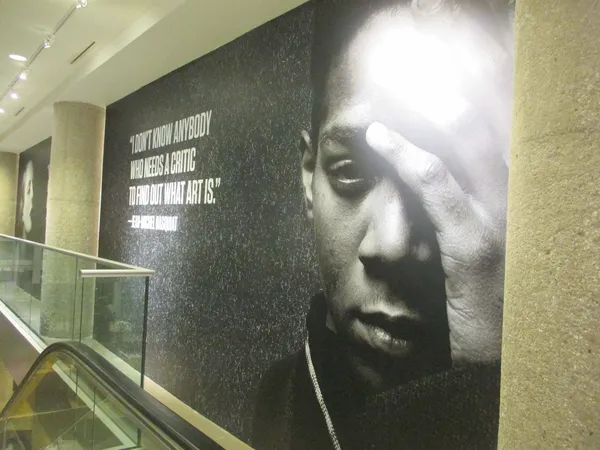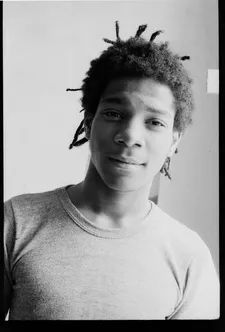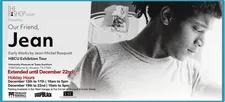 |
| Jean-Michel Basquiat at Sotheby’s: “I don't know anybody who needs a critic to find out what art is." Photo: Anne-Katrin Titze |
In the second installment with Sara Driver and Alexis Adler on Jean-Michel Basquiat, we discuss a panel at The New School with Al Diaz, Michael Holman and Annina Nosei that Alexis attended, Kevin Young’s book To Repel Ghosts, Afrika Bambaataa at the Ritz, Public Enemy (Chuck D and Flavor Flav) at The World, Spring/Break, and the Bishop Gallery connection to her recent HBCU (Historically Black Colleges and Universities) Our Friend, Jean tour.
Also: Sara on prophet artists (William Burroughs, JG Ballard, Basquiat), Beck Underwood’s fantastic Super 8 clothesline animation for the Michael Holman Gray story, screening Boom For Real: The Late Teenage Years of Jean-Michel Basquiat at Miami Basel, and teaching kids at NYU to “make your mistakes.”
 |
| Sara Driver with Alexis Adler and Anne-Katrin Titze on New York in the late Seventies, early Eighties: “I think as humans we want community and there was such a strong sense of community.” |
From New York, Sara Driver and Alexis Adler (after having been joined by music producer and 99 Records founder Ed Bahlman) continued with me on Zoom for more of our in-depth conversation on Jean-Michel Basquiat, the strong sense of community and everything happening at the same time in New York during the late Seventies, early Eighties.
Anne-Katrin Titze: Alexis, you tell the story of Jean-Michel saving you and Felice [Rosser]? That situation sounded quite dangerous. So you owe him your life?
Alexis Adler: Or something! He saved us.
AKT: The film is so full of stories.
Sara Driver: That was the beauty. I think it’s also good to encourage kids now. Everything is so departmentalized and we need to germinate. We were germinating. What Ed said, there were no boundaries with music or painting or writing …
AA: … or video. Everything was happening at the same time. For the music there was different genres, different styles and everything was mixing together. We were punk rock and new wave and then all of a sudden we were being exposed to hip-hop. I went up to the Bronx once and was like wow. There was this show at the Ritz in ’81 and Afrika Bambaataa came down to the Mudd Club. Public Enemy was down at The World. Jamaicans were coming in and we were getting World Music - it was really great.
AKT: And from what I understand, you didn’t have to be perfect from the start. There was an opportunity to learn.
SD: Yes, and to make mistakes. When I was teaching at NYU the kids were so afraid to make mistakes and that’s how you learn. Make your mistakes!
AA: Look at Jean’s art! If he didn’t like something he would just paint over it, paint over a part of it or cross it out. And he just kept going, it didn’t stop him from doing something.
AKT: It’s very inspiring. There is this 40-year theory. When Mad Men came out and changed TV in the early 2000s it went back to the Sixties. There were all these films in the Seventies looking back at the Thirties, such as Chinatown or the Raymond Chandler movies [in fashion the Eighties revived the shoulder pads popular in the Forties; 1940s movies are full of nostalgia for the turn of the century, etc.]
 |
| M I L K by Jean-Michel Basquiat, collection Alexis Adler Photo: courtesy of Alexis Adler |
Before going on Zoom with you, I just thought that the Eighties are now at that 40-year point. Maybe there lies an explanation why right now you have so many different people, who may not have experienced these times as an adult, who may have been born then - have a fresh look. I just wanted to share this with you.
SD: Well, it is interesting! I think as humans we want community and there was such a strong sense of community. I think that’s what excites people to know about what was happening in downtown New York in the late Seventies and early Eighties. There was such a strong community force and we got strength from that. But the 40-year theory is very interesting!
AA: My son was at the New School and he said “Mom, there’s a seminar, panel about Jean-Michel!” I said “Oh, let’s go.” So we went together. It was like 2012 and I come upon this room packed full of young people who were hungry to find out about Jean.
On the panel was Al Diaz and Michael Holman and Annina Nosei, It was just people wanted to know and I thought wow, this is interesting. And I think the interest has only built from then. He’s always been acknowledged as this great artist, but for whatever the reasons, there’s renewed interest.
SD: I think he’s also one of those prophet artists. What his work was saying about race 40 years ago is relevant now. Like Burroughs or JG Ballard, these people who predict and stay relevant through time are great artists really. You know, the film was picked to show at Miami Basel [in 2017]. And I went down with Lee [Quiñones].
 |
| Jean-Michel Basquiat portrait by Alexis Adler Photo: Alexis Adler |
They only pick one film to show at Miami Basel each year. And the audience was full of kids and they all wanted to know: how do we do this? How do we make art? How can we be together? Here we are in the art world Mecca and the kids have found this movie and are desperate to know how can they have a Times Square show?
The fact that I’ve been really happy with about the film is I’ve had people write me and tell me that they’ve gone back to their own work. That they felt instigated by the film to get their own voices heard, to get their own signals out. And I also feel that with the Lee film; that that is where it’s going to go. Because Lee is an innate artist, he’s a born artist. The flame is so hot in him. And that’s inspiring for everybody.
AA: Yes. I’ve just been part of this tour of HBCUs, which are the historically Black colleges and universities in the South. They were the first institutions that allowed Black people to get educations. And this gallery I’m associated with, Bishop Gallery, in Brooklyn, had this idea to bring Jean’s art to these colleges. We were on a six-stop tour this fall and it was so great to bring this art to these young Black students.
This is early work, but this will be the only Basquiat work they will ever be able to see in-person for the most part. Because, you know, 90% is in private hands. The chief curator just told me that the work gets sold to Russian oligarchs who have no intention of ever showing that work for shows or anything.
And the shows, they don’t go to Tennessee or wherever; they go to New York and London and Paris. These people down south don’t get that opportunity, so it was really great to be able to share it. The students were so stimulated by the work, the conversation, everything.
SD: It’s so great you did that. Also with Spring/Break we felt the same way. That was the first exhibit that you had of your photographs and of the work.
AA: Yes.
 |
| Alexis Adler show Kevin Young’s To Repel Ghosts to Sara Driver, Anne-Katrin Titze, and Ed Bahlman |
SD: That was in the old post office on 34th Street. I remember you unwrapping the photographs and it was like - Jean belongs here! It was perfect, because it was dilapidated, you know, the upper floors of the post office that pigeons and everybody else had taken over. We didn’t publicize that this was going to be there, much to the curator’s … So people just stumbled upon it. It was kind of amazing to see the reactions, right Alexis?
AA: Yes, and then eventually it got press and people started coming by.
AKT: When was that?
AA: That was in the spring of 2015. I had just gone to Africa and came back and did this. The curator is the director of the American Smithsonian African American collection in Washington and I donated a piece from my collection to the Smithsonian a year and a half ago. We had a big ceremony. They had no Basquiat work at the African American collection. None.
SD: They can’t afford it!
AA: Now they have one and so thousands of people can see it.
SD: One of my favourite pieces is a beautiful little flag.
AA: I’ll show you [Alexis walks around her apartment to show us some of the works].
 |
| Alexis Adler shows us Flag book image by Jean-Michel Basquiat |
SD: It’s a piece he used to carry crumpled in his pockets, right Alexis?
AA: Yes. This is a sculpture that Jean did [she shows us the M I L K artwork on the wall]
Ed Bahlman: When I saw M I L K in the film I thought of Martin Luther King.
SD: That’s interesting. [Alexis shows the flag on the back of a catalogue to us] I love the flag and it’s tiny.
EB: Who animated the Michael Holman story with the set for Gray?
SD: My friend Beck Underwood [Super 8 clothesline animation] She’s fantastic.
EB: That story is hilarious.
AA: This guy Kevin Young [Alexis holds up his book To Repel Ghosts] is the director of the Smithsonian now and he wrote a book of poems about Jean-Michel. When we had the ceremony and I gave the flag there, he’s like “Can I read a poem?” And we look at him, like “You’re asking us if you can read a poem? Go for it!” It was funny.
 |
| Our Friend, Jean, co-curated by Alexis Adler, University Museum at Texas Southern |
The Our Friend, Jean exhibition, curated in conjunction with Alexis Adler, was presented at Hampton University, Howard University, Clark Atlanta University, Tennessee State University, Dillard University, and Texas Southern University. The Bishop Gallery partnered with Group Black on the tour from October 3 through December 4 2022 that featured early works of Jean-Michel Basquiat.
Read what Sara Driver and Alexis Adler had to say on how the original idea for Boom For Real: The Late Teenage Years Of Jean-Michel Basquiat came over tea at the apartment Alexis shared with Jean-Michel. With Ed Bahlman they discuss the thriving creative world of New York City in the late Seventies, early Eighties.





















